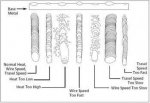A-one
Well-known member
I have a Lincoln Pro Mig 180. I'm thinking that since I'm only running flux core for now, I need to keep .030 for thinner material and .045 for thicker (since I did go ahead and get the .045 kit). Don't really see the need to fool with any .035. I'm messing around with 10-16 gauge most of the time. People bring me lawn furniture and other items that are thinner than the 16 gauge from time to time. I get the occasional 1/4" pieces here and there. If im looking at this wrong, somebody let me know.
Last edited:



